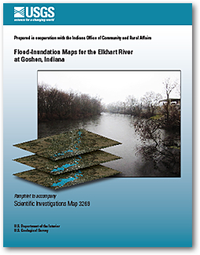The U.S. Geological Survey (USGS), in cooperation with the Indiana Office of Community and Rural Affairs, created digital flood-inundation maps for an 8.3-mile reach of the Elkhart River at Goshen, Indiana, extending from downstream of the Goshen Dam to downstream from County Road 17. The inundation maps, which can be accessed through the USGS Flood Inundation Mapping Science Web site at
http://water.usgs.gov/osw/flood_inundation/, depict estimates of the areal extent and depth of flooding corresponding to nine selected water levels (stages) at the USGS streamgage at Elkhart River at Goshen (station number 04100500). Current conditions for the USGS streamgages in Indiana may be obtained on the Internet at
http://waterdata.usgs.gov/. In addition, stream stage data have been provided to the National Weather Service (NWS) for incorporation into their Advanced Hydrologic Prediction Service (AHPS) flood warning system
(http://water.weather.gov/ahps/). The NWS forecasts flood hydrographs at many places that are often colocated with USGS streamgages. NWS-forecasted peak-stage information may be used in conjunction with the maps developed in this study to show predicted areas of flood inundation. In this study, flood profiles were computed for the stream reach by means of a one-dimensional step-backwater model. The model was calibrated using the most current stage-discharge relation at the Elkhart River at Goshen streamgage. The hydraulic model was then used to compute nine water-surface profiles for flood stages at 1-foot (ft) intervals referenced to the streamgage datum and ranging from approximately bankfull (5 ft) to greater than the highest recorded water level (13 ft). The simulated water-surface profiles were then combined with a geographic information system (GIS) digital-elevation model (DEM), derived from Light Detection and Ranging (LiDAR) data having a 0.37-ft vertical accuracy and 3.9-ft horizontal resolution in order to delineate the area flooded at each water level. The availability of these maps, along with Internet information regarding current stage from USGS streamgages and forecasted stream stages from the NWS, provide emergency management personnel and residents with information that is critical for flood response activities such as evacuations and road closures as well as for postflood recovery efforts.


